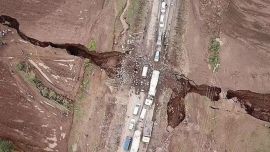Rina wanders half-naked and barefoot next to a rubbish dump in the port city of Guayaquil. She’s on "H," a cheap, addictive drug on the rise among Ecuador's poorest people.
Rina’s image was captured on video on New Year's Eve and brought to the attention of municipal health officials who came to her rescue.
"When I use, I hear voices," the 24-year-old, who does not give her real name, tells AFP.
She is now bedridden in a city clinic where she is undergoing detoxification treatment, her second in less than a year.
Rina stole and prostituted herself to buy "H," a heroin-based white powder that sells for a dollar a gram, while cocaine sells for between three and five dollars.
“H" is cheaper, but it’s also more toxic.
In the drug, "we have found lime, cement, ether, rat poison and even ketamine, a painkiller used on horses," explains psychiatrist Julieta Sagñay of the Instituto de Neurociencias, a Guayaquil-based NGO that treats addicts.
In Guayaquil, a hub for drug-trafficking, 162 kilos of this synthetic drug were seized in 2022, according to official figures.
Sagñay receives more and more "H" users, suffering from a worse deterioration than any of his other patients.
"If anyone has seen the zombies in Philadelphia, where there are addicts walking around bent over, we already have that in Guayaquil," says the specialist, who has more than 30 years of experience in addictions.
After six months of consumption, an “H” addict moves his legs incessantly, constantly scratches himself, and does not sleep or eat. The withdrawal symptoms are so lethal, Sagñay points out, that they cannot be endured without at least eight days of pharmacological treatment.
'Nazi' clinics
Guayaquil has three public addiction clinics that cannot cope with the number of “H” addicts seeking treatment. There are more than 30 private clinics, but they can cost up to US$700 a month in a country with a minimum wage of $US450 per year.
For this reason, when addiction strikes, some "H addicts" desperately turn to clandestine detoxification centres.
"They beat me, put me in a bucket of cold water and we ate chicken heads every day," recalls Hugo Mora, who some four years ago was in a dirty, dingy, windowless illegal clinic where he paid US$150 a month to stop snorting or smoking "H."
He couldn’t do it.
The 24-year-old has been in the Bicentennial Municipal Hospital in Guayaquil for a week, after 'treatment' at two "Nazi" clinics, as he calls the clandestine ones because of their macabre methods such as beatings, confinement and starvation diets.
Fires are frequent there, set by the patients themselves in attempts to escape. In 2019, 18 people died after they set fire to the mattresses in an informal clinic a cry for help.
Mora feels more relieved since he has been at the Bicentenario, he tells AFP from his stretcher in a large white-walled room with 14 beds, 11 of which are occupied.
This hospital receives up to 150 patients a day and 90 percent are for "H" consumption, the authorities said.
Sick and persecuted
The "H" cocktail contains less than three percent heroin, estimates Segundo Romero, a forensic psychologist and retired police officer.
"Because there is so little pure drug, the addict needs to consume more and buys more," he says.
From one gram of heroin, the micro-trafficker gets 40 grams of "H," a concoction that causes psychotic symptoms and hallucinations.
In Durán, a city opposite Guayaquil, Cerro Las Cabras is known as a drug supermarket, where the sale of "H" moves up to US$1 million a month, according to official estimates.
From his police days, Romero remembers sinister remnants of "H."
In a prison, he found several inmates with their faces covered in powder. "As they had no more drugs, they had scratched the walls and put white paint in their nostrils," he recalls.
According to the research centre Insight Crime, "H" was funnelled into Guayaquil around 2011, with the help of Colombians looking to expand the heroin market. Local gangs are now profiting from the current boom, fighting over the burgeoning business.
A 13-year-old emaciated gang member, who made his debut in drugs with "H", answers the doctor's questions in the Bicentenario sporadically.
A native of the province of Esmeraldas, on the border with Colombia, he arrived a few days ago begging for help because of his addiction to multiple substances.
His relatives fear that he could be hospitalised and become easy prey for drug traffickers.
"The older brother has already been killed and he is now being chased by the opposing gang," his uncle deplores on condition of anonymity.
by Karla Pesantes, AFP



















Comments